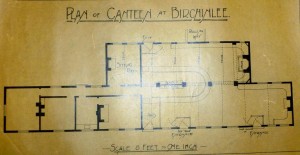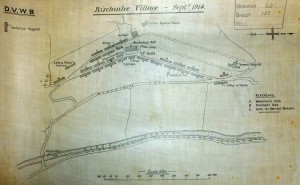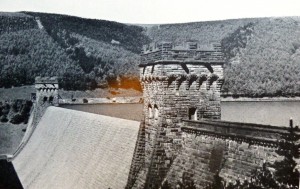April 17, 2012, by Sarah Colborne
Tin Town: village of the dam builders
One of the most exciting finds amongst the water archive material I am cataloguing for the Water Records Project, is a series of significant architects plans for various buildings which formed the ‘Tin Town’ at Birchinlee, Derbyshire. When work started in 1901 on the construction of the Howden and Derwent Dams, the Derwent Valley Water Board (1899-1974) set up this temporary village to house the workers and their families. Huts were constructed with galvanised corrugated iron sides (hence the nickname), and by 1909 the population of the village reached a maximum of 967. A few remnants of the village can still be seen today.
During the period of the construction of the great public works such as railways and dams, groups of nomadic workers known as navvies, would travel huge distances looking for employment, sometimes ending up sleeping rough near construction sites. The 1899 Derwent Valley Water Act stipulated that the Board should provide sufficient and sanitary accommodation for the workmen they employed and considerable thought went into providing an environment which would foster moral behaviour!

Plan of the canteen, c.1900-1914. Derwent Valley Water Board minutes record a dispute with the Temperance Movement over the existence of a bar in the village
Huts were provided for families, whilst single men were housed in small groups with the ‘ganger’ and his family. Other buildings included a school, shops, bath-house, police station, canteen, and recreation hall. Unfortunately we do not have any photographs in our water collections to show the sumptuous interiors of the huts, which were decked out with pot plants, ornaments and family portraits, but many have been reproduced in the book ‘Birchinee: the workmen’s villlage of the Derwent Valley Water Board’ by Professor Brian Robinson, whose mother grew up there. If anyone knows how to get in touch with Brian Robinson, we would love to speak to him!



I have just come across your article online. Brian Robinson is my Uncle and has passed on some of the original plans for the buildings at Birchinlee which he rescued from a skip when he was researching his book called Walls Across the Valley. I would be keen to see the plans that you hold relating to any buildings in the Village.
Hi Paul. Is there any way to get in contact with your uncle Professor Brian Robinson? I am George Eustace Charles Sutton’s great great granddaughter (he had a huge part in the success of Birchinlee and the community), I’d love to know if he had any information about him and his work?
Kind regards, Heather
Please drop me an email paul.robinson@cityestates.com. I can speak to Uncle Brian and see what information he has. I am sure that he will have something for you.
Dear Sir/Madam, I came across the comments with regards to the ”Birchinlee community 1901-1914”, and would be most grateful for any information appertaining to a list of names of the ”Navvies” who worked and lived there, assuming of course if one exists. I would imagine that the Derwent Valley Water Board would have had names of their employees at that time. My Paternal Grandfather, George Harold Wallace(1878-1926) was said to have worked there between 1901 and 1906 as a fireman by one of my cousins.
Kind regards,
Stan Kirkby
Hi Stan
I don’t have any records but it is possible that Brian may know something. I guess that you have already tried the 1901 census for the village to see if he is listed?
Kind regards
Paul
Paul … if my memory serves me we are cousins . Roger and Barbara … “ Auntie Barbara “ always so kind and never forgot a Birthday especially my 50th . Lovely lady . Uncle Brian is my biological father .
Interested that you are in contact and fuelling this Derwent / Tin Town ongoing project . Why ? You are aware of the history .
Hi Johanna
Your memory is correct – we are cousins. Thank you for your kind words regarding Mum and Dad, both of whom are no longer with us.
I was doing some family history stuff and Birchinlee was where Granny was born. I wanted to find out where the family had come from prior to arriving there to work on the dams.
Feel free to email me at paulrobinson182@btinternet.com as I only tend to look at this post once a year (hence the delay in replying!)